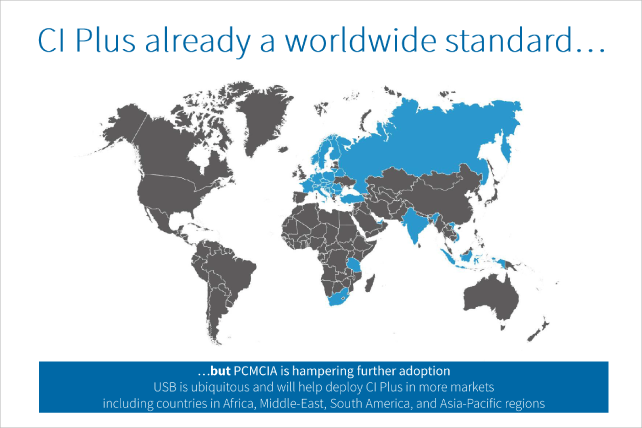The continued evolution of the CI Plus family of specifications is opening new horizons for pay-TV operators and consumers alike. That was one of the key takeaways from this week’s DVB webinar titled When USB meets Pay-TV – an update on CI Plus. In particular, the new USB form factor for connecting a conditional access module to a TV set makes possible compelling new products and services.
The webinar was presented by Nicholas Frame, standardization manager at TP Vision and chair of DVB’s technical working group for CI Plus. The full video plus the slides he presented are available here.
The CI Plus ecosystem is the result of a joint effort involving the DVB Project and CI Plus LLP. It is based on the DVB Common Interface specifications, the bedrock of pay-TV services since the late 1990s. The second generation DVB-CI specification, published in 2018, introduced the USB form factor as a replacement for the familiar but cumbersome PCMCIA card.
CI Plus LLP creates “wrapper” specifications that profile the DVB-CI specifications, with the goal of aiding market implementation. The work of CI Plus LLP covers matters such as certification, the requirements of content distributors and monitoring the market for fraudulent usage.
Benefits of USB
The move to a new form factor for CI Plus has not entailed starting from scratch. Version 2.0 builds on the features and security level of the previous version 1.4, adding the benefits of USB. While PCMCIA cards are likely to remain in the market for some time to come, the introduction of USB enables implementers to future-proof their offer. It has the benefit of being a widely recognized format and is highly customizable, thus creating new branding and marketing opportunities.
Among the new possibilities opened with CI Plus 2.0, the webinar included the example of combining it with the HbbTV Operator App specification to enable a kind of virtual set-top box. While the earlier version of CI Plus already offered interesting benefits, such as having a single remote control, operator channel-list management, and access to premium UHD/HDR content thanks to enhanced content protection (ECP), with USB and HbbTV OpApp operators can have full control of the UI look and feel. Importantly, in terms of sustainability, there would also be significantly lower power consumption, with the removal of a need for an extra box.
Market developments
While DVB’s CI working groups are in sleep mode at present, they can be reactivated as and when new features are demanded by the industry. In the meantime, CI Plus LLP will continue to update its wrapper specs. It is also considering how a new logo initiative might benefit implementers and consumers.
In terms of wider market developments, the German TV Platform is holding a series of industry consultations on CI Plus 2.0, with interested stakeholders invited to participate. (The next sessions are scheduled for 17 June, 22 July and 26 August. Contact the organization to participate.)
Additionally, the Telecom Regulatory Authority of India has recommended mandatory support for CI Plus 2.0 for TVs and STBs in that country. Discussions between the relevant ministries and industry bodies are on-going.

